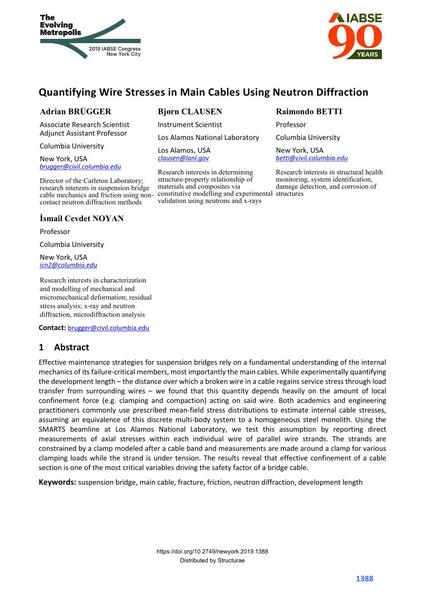Quantifying Wire Stresses in Main Cables Using Neutron Diffraction

|
|
|||||||||||
Bibliographic Details
| Author(s): |
Adrian Brügger
(Columbia University)
Bjørn Clausen (Los Alamos National Laboratory) Raimondo Betti (Columbia University) |
||||
|---|---|---|---|---|---|
| Medium: | conference paper | ||||
| Language(s): | English | ||||
| Conference: | IABSE Congress: The Evolving Metropolis, New York, NY, USA, 4-6 September 2019 | ||||
| Published in: | The Evolving Metropolis | ||||
|
|||||
| Page(s): | 1388-1392 | ||||
| Total no. of pages: | 5 | ||||
| DOI: | 10.2749/newyork.2019.1388 | ||||
| Abstract: |
Effective maintenance strategies for suspension bridges rely on a fundamental understanding of the internal mechanics of its failure-critical members, most importantly the main cables. While experimentally quantifying the development length – the distance over which a broken wire in a cable regains service stress through load transfer from surrounding wires – we found that this quantity depends heavily on the amount of local confinement force (e.g. clamping and compaction) acting on said wire. Both academics and engineering practitioners commonly use prescribed mean-field stress distributions to estimate internal cable stresses, assuming an equivalence of this discrete multi-body system to a homogeneous steel monolith. Using the SMARTS beamline at Los Alamos National Laboratory, we test this assumption by reporting direct measurements of axial stresses within each individual wire of parallel wire strands. The strands are constrained by a clamp modeled after a cable band and measurements are made around a clamp for various clamping loads while the strand is under tension. The results reveal that effective confinement of a cable section is one of the most critical variables driving the safety factor of a bridge cable. |
||||
| Keywords: |
suspension bridge friction neutron diffraction main cable fracture development length
|
||||
